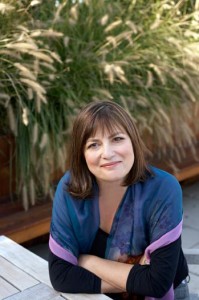Alice Hoffman discusses the process behind fiction
“Magical” is a word frequently used to describe the writing of Alice Hoffman, but that does not, by any means, make her a predecessor to J.K. Rowling.
There are no wizards or sorcerers in Hoffman’s novels, though witches or apparitions do occasionally weave themselves in and out of her narratives. 
Instead, Hoffman’s magic is seamlessly and ironically juxtaposed with realism as she explores the innate bonds between mothers, daughters and sisters, along with the human race’s inexplicable ties to plants, animals and the wild temperament of Mother Nature.
Hoffman, a prolific novelist who has penned more than 30 books, let an audience of devoted readers in on the secrets to her inspiration Monday.
The event that took place at the Writers Guild Theater in Beverly Hills was sponsored by Writers Bloc Los Angeles, a lecture series that hosts novelists, journalists and screenwriters.
Just as her characters come to understand the mysticism that flourishes in their lives, Hoffman said she uncovers magic every day when she settles before her laptop in a quiet room.
“Fiction really comes alive when the characters start to have enough life that they make their own decisions,” Hoffman said. “The process is finding out what the story really is.”
KUSC program director and radio host Gail Eichenthal mediated Monday night’s discussion, which mostly centered on Hoffman’s latest novel, The Red Garden.
The novel links together 14 stories, each of which easily could stand on its own.
The Red Garden is both Hoffman’s love letter to New England, where she has lived for 30 years, and an artwork of storytelling.
Beginning in 1750, the novel explores nearly 300 years of history of a small Massachusetts town through its people, its ghosts and even its animals.
“[The Red Garden] is really about the importance of stories and how family stories become history,” Hoffman said. “Over the 300-year history of this town, the stories that people tell each other become shared mythologies.
It is appropriate, then, that the first tales Hoffman remembers hearing as a child were from her Russian grandmother, which led to her fascination with these often whimsical oral histories.
“I was also a fairytale and folk-tale fanatic. I think that gave me the first sense that literature and magic go hand-in-hand,” Hoffman said.
A voracious reader in her teens, Hoffman was inspired by J.D. Salinger’s The Catcher in the Rye, immediately enraptured by Holden Caulfield’s distinct voice.
“It was the first time I felt that a character was speaking directly to me. There’s this intimacy and this feeling that you’re known in some way,” Hoffman said. “I feel like that’s what you want from fiction — you want to feel known when you read a novel.”
Hoffman and Salinger’s voices differ, but they do share a brilliance in their language, which Hoffman refined at Stanford University, where she received her MFA in creative writing in the early 1970s.
While at Stanford, Hoffman not only honed her style but also realized that writing was her true vocation.
“Nobody cares if you get up every day and write. There has to be some reason you get up every day to do it,” she said. “I don’t think it’s so much you have a story to tell, it’s that you have questions you need answered. You’re writing to find answers to certain questions.”
These questions keep Hoffman’s work grounded in everyday situations and sentiments, despite the occasional forays into the mystical.
A breast cancer survivor, Hoffman continued to craft narratives while undergoing radiation treatment — an experience that inspired several of her novels, including The Ice Queen.
“I was writing these stories to give myself the strength,” Hoffman said.
As much as Hoffman has drawn from her life and the world around her, she also insists that one doesn’t always have to undergo an experience in order to understand it as a writer.
“You’re told as a writer to ‘write what you know,’ and I don’t believe that,” she said. “You should write what you feel.”
